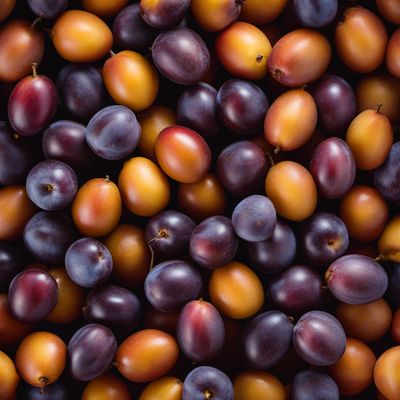
Ingredient
Camu camus
The Mighty Camu Camu
Camu camu is a small, round fruit with a vibrant orange color and a tangy, citrusy flavor. It has a slightly sweet and sour taste, similar to a combination of lemon and cherry. The fruit is typically harvested when fully ripe and is commonly used to make juices, smoothies, desserts, and even supplements due to its high vitamin C content. Its pulp is soft and juicy, while the skin is thin and delicate. Camu camu is also available in powdered form, which is a convenient option for adding a boost of vitamin C to recipes.
Origins and history
Camu camu has a long history of traditional use by indigenous communities in the Amazon rainforest. It has been an important part of their diet and traditional medicine for centuries. The fruit is native to the Amazon basin in South America, particularly Peru and Brazil. It grows on small shrubs or trees that thrive in the wet and swampy areas of the rainforest. Camu camu has gained popularity worldwide in recent years due to its high vitamin C content and potential health benefits.
Nutritional information
Camu camu is a nutritional powerhouse, known for its exceptionally high vitamin C content. It also contains antioxidants, such as anthocyanins and flavonoids, which help protect the body against oxidative stress. Additionally, it provides small amounts of other essential nutrients like potassium, calcium, and iron. Camu camu is low in calories and fat, making it a healthy addition to a balanced diet.
How to select
When selecting fresh camu camu, look for fruits that are firm, plump, and free from blemishes or mold. The skin should be smooth and brightly colored. If purchasing powdered camu camu, opt for reputable brands that source their products from reliable suppliers and ensure high-quality standards.
Storage recommendations
To maintain the freshness and quality of camu camu, store fresh fruits in the refrigerator. Place them in a perforated plastic bag or an airtight container to prevent moisture loss. Powdered camu camu should be stored in a cool, dry place away from direct sunlight. Ensure the packaging is tightly sealed to prevent exposure to air and moisture.
How to produce
Camu camu is typically grown in the Amazon rainforest, making it challenging for amateur gardeners to produce. However, if you live in a tropical or subtropical region with similar climatic conditions, you can try growing camu camu from seeds or cuttings. It requires a moist and well-drained soil, plenty of sunlight, and regular watering. Patience is key, as it may take several years for the plant to bear fruit.
Preparation tips
Camu camu can be used in various ways in the kitchen. Fresh camu camu fruits can be juiced, blended into smoothies, or used to make sauces, dressings, and desserts. The powdered form can be added to beverages, baked goods, or sprinkled over yogurt and cereal for an extra dose of vitamin C. It pairs well with other tropical fruits, citrus flavors, and chocolate. Experiment with different recipes to explore its tangy and refreshing taste.
Culinary uses
Camu camu is commonly used in traditional Amazonian cuisine, particularly in Peru and Brazil. It is often incorporated into beverages like juices, cocktails, and traditional fermented drinks. The fruit's tangy flavor adds a refreshing twist to desserts, such as ice creams, sorbets, and mousses. It is also used in sauces, jams, and jellies. In recent years, camu camu has gained popularity as a superfood ingredient and is used in various health supplements and functional foods.
Availability
Camu camu is primarily cultivated in the Amazon rainforest regions of Peru and Brazil. It is also grown in other tropical countries, including Colombia and Ecuador. The fruit is harvested from wild-growing shrubs or cultivated on small-scale farms in these regions. Additionally, camu camu is exported to different parts of the world, making it available in specialty stores, health food markets, and online retailers.
More ingredients from this category » Browse all

Water berries
"The Refreshing Gems: Exploring the World of Water Berries"

Acerolas
Vibrant Superfood Berries

Otaheite gooseberries
The Tropical Delight: Otaheite Gooseberries

Hog plums
The Tangy Delight

Coco plums
The Tropical Delight

Grumichamas
The Exotic Brazilian Berry

Water pears
The Refreshing Delight: Exploring the World of Water Pears

Arbutus berries
The Scarlet Gems of the Forest

Surinam cherries
Exotic Tangy Gems

Jambuls
The Purple Powerhouse: Unveiling the Secrets of Jambuls

Carandas
The Tangy Jewel of the Tropics

Sea grapes
The Ocean's Delicacy: Sea Grapes